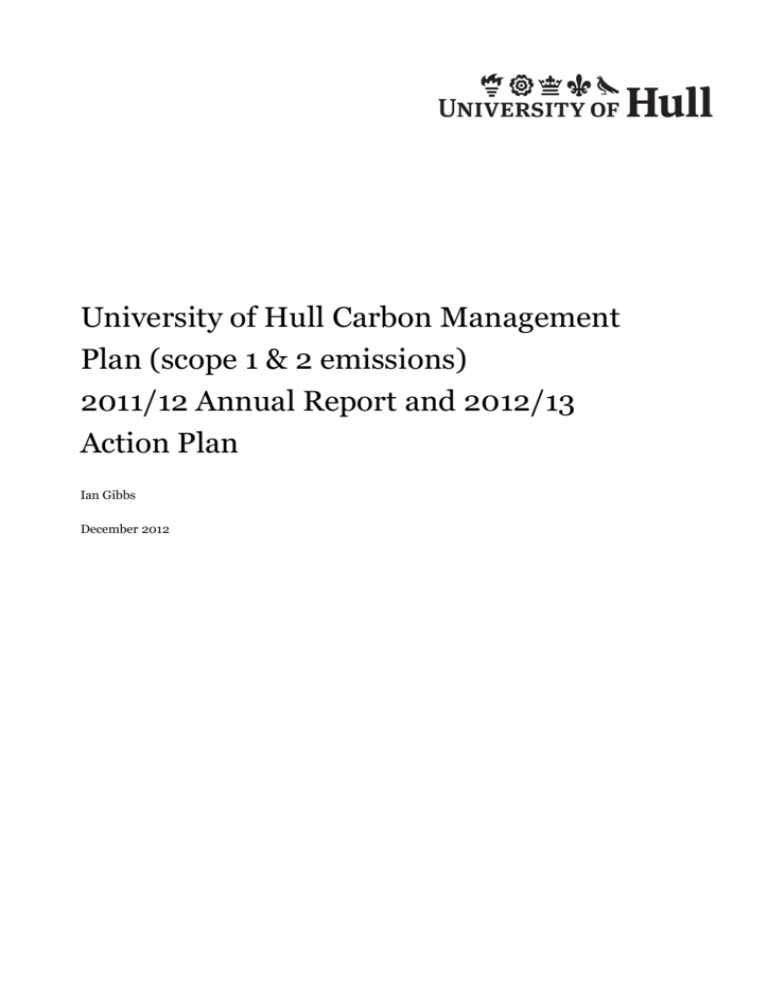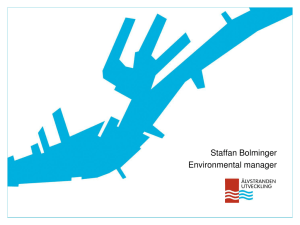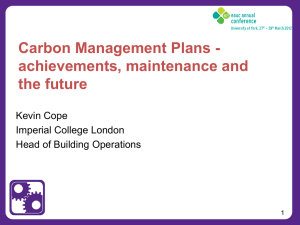Address 1 - University of Hull
advertisement

University of Hull Carbon Management Plan (scope 1 & 2 emissions) 2011/12 Annual Report and 2012/13 Action Plan Ian Gibbs December 2012 The University of Hull Carbon Management Plan Annual Report 1. Introduction This is the University’s 2011/12 Carbon Management Plan (CMP) annual report for the financial year 2011/12. It is the first annual report and provides details on progress achieved and performance improvements made in reducing emissions of carbon dioxide (CO2) against University targets. The University’s CMP was approved in November 2011 and can be found at http://www2.hull.ac.uk/administration/pdf/CMP_Nov_2011.pdf with further information on The University's environmental web. The CMP was approved by the Vice Chancellor at an executive meeting on the 13th February 2012 a copy can be found here . The CMP includes targets for reductions in emissions of CO2 from energy usage. It identifies the principal areas of energy use and investment programmes required to improve energy efficiency, reduce usage and generate energy from renewable energy sources. Electricity consumption fell by 7% (712 tCO2) in 2011/12 from 2010/11. However, gas consumption rose by 19% (1,335 tCO2). This rise is due to the harsh winter during semester times with space heating running well into May and also the addition of gas fired heating equipment to Taylor Court. The significant degree day increases were seen in February (356/273), April (294/154) and May (210/130). Additionally, some of the mechanical plant was run for twenty four hour periods during the winter to prevent damage to heating coils. Total emissions for 2011/12 were 18,505 tCO2. This falls short of our carbon reduction target by 534 tCO2. Carbon reduction measures installed in 2011/12 will not see their full effects until reporting in 2012/13. Significant emission reductions (1,179 tCO2) are needed in 2012/13 to enable us to get back on target. This will be very challenging as we expand our estate and install energy consuming services within them. To meet our targets, it is imperative that we; Install further low energy technologies within our buildings Introduce a Space Heating Policy Change behaviour Consider Renewable Energy options A budget of £300k should be made available for the implementation of further low energy measures saving £49k/yr and 235 tCO2/yr for implementation 2012/13. CMP Report 2011/12, December 2012 2/12 The previous year's investment has not shown full year effects and it is predicted that the investments made in energy efficiency measures during 2011/12 will produce further emissions reductions when reporting in 2012/13. However the commissioning of new buildings at Allam Institute will increase CO2 emissions by 160 tCO2/yr together with the additional measures that are forcing energy usage upwards. In particular, we need to review our space heating control systems through the Building Management System and undertake a full assessment on heating start times and set points. This will be more easily enforced with approval of The Space Heating Policy. Numerous low simple payback projects have been implemented over the last five years. Therefore, it is becoming more difficult to identify technology energy reduction initiatives that have a payback of less than 7.5 years. On completion of the 2012/13 technology implementation plan (£300k). The University will have deployed the following; All wall thermal elements cavity insulated All lofts insulated to Building Regulations Standard 80% of gas fired boilers used for space and hot water heating will be high efficiency condensing boilers 80% of areas will have lighting controls (occupancy & daylight) fitted All plant rooms and hot distribution pipework fully insulated Should The University invest in technologies with higher payback than 7.5 years in order to meet the carbon reduction targets? We are currently (2012/13) having to invest approximately £1,276/tCO2 reduction with a six year simple payback. If we were to invest annually at this level to achieve our annual CO2 reduction target of 645 tCO2/yr then we would need to invest £823k per year to 2019/20, £5.6M in total. This figure is a minimum since further implementation will make it harder to find reduction measures increasing annually the £1,276/tCO2 figure. Carbon Reduction Commitment Energy Efficiency Scheme The University has registered with the Environment Agency for the Carbon Reduction Commitment Energy Efficiency Scheme. Our carbon footprint report and first annual report were developed with internal audit and submitted in July 2011. The annual cost for our carbon footprint for the period April 2010 – March 2011, using emissions of 18,245 tonnes CO2 and a price of £12/tonne CO2, will be £222k. The student houses on both Cranbrook and Auckland Avenue have been excluded under the CRC 90% obligation rule to minimise administration time and costs. The current price of carbon under the CRC EES is £12/tCO2. Therefore, this equates to annual allowance purchases of £222k per annum. The price of carbon is set to increase to £30/tCO2 by 2020 increasing allowance sales to £555k unless TUOH reduces its carbon emissions. CMP Report 2011/12, December 2012 3/12 Progress against Targets Emission Factors Electricity and gas emission factors are used to convert consumption to tonnes of CO2. Emission factors should be revised annually to take account of the current power sector fuel mix as documented in (HEFCEd, 2010, pp.Table 2-2). Emission factors for electricity and gas have reduced due to the net importation of nuclear energy from France. Following a review of this methodology it has been decided to revise it to factor in electricity imports in this 2011 update for the full time period. In general the UK is a net electricity exporter to Ireland and a net electricity importer from France. Because France has significantly lower emission factors for electricity generation (as electricity is predominantly produced from nuclear power) this has resulted in a reduction in the UK grid average emission factors across the time-series. The degree to which these have changed varies by year according to the relative proportion of electricity imported. Emission factors should be updated for historical reporting with each annual update one should recalculate emissions from previous years using the latest time-series dataset. This is because there can be revisions to earlier emission factor data due to improvements in the calculation methodology or UK GHG inventory datasets they are based upon. For example in this 2011 update: Figure 1 - Emission Factors (DECC, 2011) The historical emissions for 2009/10 and 2010/11 have been adjusted to take into account the new emission factors, see below; Figure 2 - Revised Emission Factors (DECC, 2011) Fuel Emission factor (kgCO2/kWh) Electricity (2009/10) (2010/11) & (11/12) 0.48152 Gas (2009/10) (2010/11) & (11/12) 0.18322 The new annual emissions are represented below and these have been amended in Figure 3 2009/10 (Systemslink Report from Facilities Directorate) CMP Report 2011/12, December 2012 4/12 The following table show the annual energy usage and carbon emissions for the various fossil fuels used on site. Figure 3 - 2009/10 (Systemslink Report from Facilities Directorate) Electricity (kWh) Electricity (tCO2) Gas (kWh) Gas (tCO2) Oil (kWh) Oil (CO2) Transport Emissions (0.71%) Total Emissions (tCO2) 22,089,491 10,636 38,517,146 7,058 0 0 126 17,820 Total degree days - 2,506 Figure 4 - 2010/11 (Systemslink Report from Facilities Directorate) Electricity (kWh) Electricity (tCO2) Gas (kWh) Gas (tCO2) Oil (kWh) Oil (CO2) Transport Emissions (0.71%) Total Emissions (tCO2) 22,144,562 10,663 38,694,325 7,089 0 0 126 17,878 Total degree days - 2,537 Figure 5 - 2011/12 (Systemslink Report from Facilities Directorate) Electricity (kWh) Electricity (tCO2) Gas (kWh) Gas (tCO2) Transport Emissions (0.71%) Total Emissions (tCO2) 20,665,339 9,951 45,979,987 8,424 130 18,505 £2.128M £1.238M Total degree days - 2,567 CMP Report 2011/12, December 2012 5/12 Energy and Carbon Costs New energy supplier contracts have recently been tendered that will be in effect throughout 2012/13. Energy costs continue to rise with an annual budget of £4.375M for 2012/13 (including water and CRC allowances). The carbon price has been assumed to remain at £12/tCO2 for 2012/13 since there is no indication from the UK Government regarding increasing this. Below are the energy costs for 2012/13 showing energy costs as outlined in the CMP (Gibbs, 2011) showing increases in costs against the CMP figures. Figure 6 - Energy Costs for 2012/13 (p/kWh) Description Base tariff CCL VAT (%) Carbon Price Total CMP Total Inc (%) Campus Electricity (Non-Domestic) 9.94 0.509 20 0.6492 13.18 13.14 +0.5 Student House Electricity (Domestic) 10.077 0.509 5 0.6492 11.76 11.58 +2 Main Campus Gas (Non-Domestic) 2.4604 0.177 20 0.22032 2.89 2.43 +20 Student House Gas (Domestic) 2.4628 0.177 5 0.22032 3.00 2.15 +40 CMP Report 2011/12, December 2012 6/12 Factors Increasing Baseline Emissions The main influencing factors increasing the business as usual scenario are; Increased building opening times including the Brynmor Jones Library Proliferation of electrical and electronic electrical equipment owned by students (refrigerators, hand held devices, microwaves and televisions) Increased use of residences during non-semester times (including Summer Schools) Refurbishment of Sports Laboratory increasing electrical load Increased use of conditioned spaces (ventilation and air conditioning) Allam Building - estimated increase of Gas – 210 MWh/yr, Elec – 250 MWh/yr - totalling 160 tCO2/yr (www.aecom.com) Extended opening hours for The Scarborough Campus Library Lincoln University occupation of Loten Hall Increased use of portable electrical heaters (Space Temperature Policy needed to mitigate) Ferens Hall increased bed spaces The increased electrical load within the refurbished Scarborough restaurant area Increased air conditioning load within Zucchini's restaurant Additional ventilation installed to Cohen Building lecture theatres Addition of large air handling units to the refurbished labs at the Scarborough campus Against the above trend, much of the plant and equipment purchased and installed by the University will have lower energy requirements than the plant it replaced (boilers, fans, pumps and computing etc.). CMP Report 2011/12, December 2012 7/12 Figure 7 - Scope 1 & 2 Emissions, Progress against Targets 25000 20000 19090 18616 16681 15000 15348 17971 17326 13974 16036 12599 14661 13287 10000 5000 0 Actual Target Water Carbon Emissions HEFCE issued a report in January 2012 by Arup and De Montfort University (HEFCEe, January 2012). This report introduced a methodology for measuring the scope 3 emissions associated with water supply and waste water treatment. The Carbon Management Plan 2011 (Gibbs, 2011) figure 9 specified targets for reduction of water consumption across the estate. This figure (Figure 8 - Water consumption and CO2 emission targets) has been updated to include the emissions associated with water usage and waste water treatment. Additionally, the progress against targets has been updated together with a list of water reduction intervention measures that should be implemented during 2012/13. CMP Report 2011/12, December 2012 8/12 Water CO2 Emission Factor (kgCO2/m3) (HEFCEe, January 2012) Provides a list of emission factors to be used for both water supply and waste water treatment see Table 1. Table 1 - (HEFCEe, January 2012) : DEFRA/DECC Life Cycle Conversion Factors The University is charged for sending 95% of its water supply to Yorkshire Water for water treatment. It is therefore possible to calculate an emission factor for combined water supply and waste water treatment per m3 of water supplied; Equation 1 - Combined Emission Factor for Water Supply & Waste Water Treatment e(watercombined) = (0.34 × 1) + (0.95 × 1 × 0.7) = 1.005 kgCO2/m3 This figure has been used to determine the emissions in Table 1. The emission factors shown in Table 1 may reduce as Yorkshire Water improves the environmental performance of their waste water supply infrastructure and waste water treatment works. Figure 8 - Water consumption and CO2 emission targets Year Water (cubic metres) 2009/10 250,468 (a) 2010/11 245,459 2011/12 240,449 2012/13 % Actual Water (cubic metres) Actual CO2 emissions (tCO2) (1.005 kgCO2/m3) 252 100 N/A 252 247 98 217,226 (£540,522) 218 242 96 210,035 (£571,468) 211 235,440 237 94 2013/14 230,431 232 92 2014/15 225,421 227 90 2015/16 220,412 222 88 2016/17 215,402 216 86 2017/18 210,393 211 84 2018/19 205,384 206 82 2019/20 200,374 201 80 CMP Report 2011/12, December 2012 Target CO2 emissions (tCO2) (1.005 kgCO2/m3) 9/12 Water Reduction Interventions Sub-metering trail on student houses The student houses are on rateable value supply and The University is therefore not charged for the amount of water that is used. The use of rateable supplied water does not encourage water conservation behaviour. A trial has therefore commenced with water meters being fitted (20/06/2012) to the following five properties; 67 Cranbrook Avenue (rateable annual cost £403.26) 73 Cranbrook Avenue (rateable annual cost £400.72) 79 Cranbrook Avenue (rateable annual cost £413.32) 85 Cranbrook Avenue (rateable annual cost £443.62) 87 Cranbrook Avenue (rateable annual cost £400.72) The average cost per property is £412.33 this relates to approximately 135 m3/yr at £3.07/m3. Since the houses are occupied by five students for roughly 270 days/yr this equates to 100 litres/student/day usage to break even with the rateable supply value. CMP Report 2011/12, December 2012 10/12 2. Intervention opportunities Implementation and Categorisation The Carbon Management Plan (Nov 2011) approved by the Vice-Chancellor detailed capital investment plans to reduce carbon emissions at Hull University. The capital investment planned for 2012/13 implementation was £300k. The categorisation of the £300k spend is shown below showing total CO2 savings, capital investment and annual energy savings. This gives a total payback period for all projects of around 6.0 years with £1,276 invested per tonne of CO2 reduced. The carbon reduction interventions within all phases have been categorised for implementation into seven groups, see below (including total values and CO2 savings); (a) Lighting upgrades and improvements to the control of existing lighting schemes. Replacement of existing lamps with more efficient alternatives. Control of mechanical and electrical services using time-clocks and other energy saving controls. (b) Insulation to plant rooms (valves, flanges, strainers, pipe-work and other ancillaries). (c) Fabric improvements to buildings (loft and cavity insulation, floor insulations, draught proofing, glazing upgrades and improvements). (d) Upgrade and replacement of mechanical services. Examples include boiler replacements, BMS controls, air conditioning controls and space heating fuel switches from electric to gas. Table 2 - Implementation Measures During 2012/13 Category Annual Carbon Savings (tCO2/yr) Annual Cost Savings (£/yr) Capital Costs (£) Simple Payback (yr) (a) Lighting & Controls 82 £20,000 £150,000 7.5 (b) Insulation 94 £16,700 £50,000 3 (c) Fabric Improvements 28 £5,000 £25,000 5 (d) Mechanical Services 31 £7,500 £75,000 10 Total 235 (35% of annual target) £49,200 £300,000 6 CMP Report 2011/12, December 2012 11/12 3. Renewable Energy Feasibility Study (Buro Happold) Installation of Biomass Boilers at The Lawns The CMP2011 identified the opportunity to save considerable amount of CO2 emissions by installing a biomass heating system at The Lawns. The CMP made a commitment to undertake a feasibility study into this by April 2012. The feasibility study has now undertaken. It will not be possible to meet The University's CO2 reduction targets without installing renewable energy technologies. With CO2 reductions of around 600 tCO2 per annum the biomass scheme at The Lawns will help The University meet those targets. The UK Government has introduced the Renewable Heat Incentive to stimulate the uptake of biomass renewable energy schemes. The RHI is the first of its kind in the world and provides long term support for renewable heat technologies like heat pumps, biomass boilers and solar thermal panels. The Biomass project is not currently viable in terms of our current payback requirements for energy saving. However, the scheme would contribute emissions reductions in the region of 600 tCO2 annually and contribute significantly to our carbon reduction targets. We will bring forward a business case in due course to seek approval to progress this project. CMP Report 2011/12, December 2012 12/12





